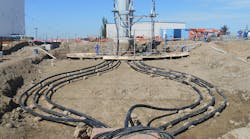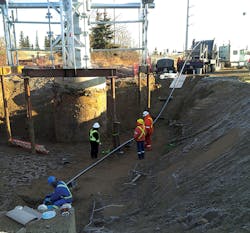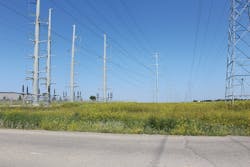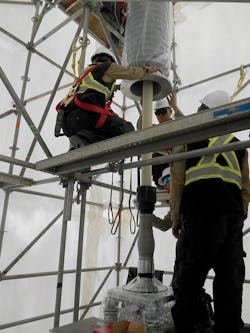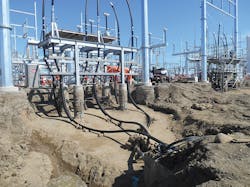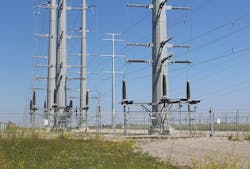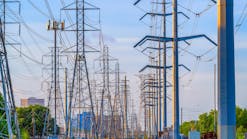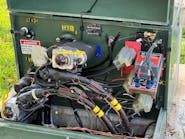In Alberta, Canada, most of the transmission grid consists of standard overhead transmission lines. While some underground transmission projects have been built—in looking at the percentage of the grid that is underground in southern Alberta—these underground additions are few and far between. So, when a project with underground is approved, it can provide some excitement compared to the standard overhead project. This type of project also can make the design challenging for those used to overhead lines, but it allows creativity to be combined with tried and proven standard construction practices. That is exactly what happened when AltaLink began looking at a different solution for a new transmission improvement project.
In recent years, multiple projects were investigated to improve the transmission grid in southern Alberta. Some of the areas AltaLink identified for improvement were congested either because of multiple transmission lines and buildings or because of proposed, new development plans. Overhead transmission is always the first option considered for economical reasons. However, because of reliability concerns and the geographic area, final approvals from the system operator included the go-ahead for some short underground sections of transmission line. These underground sections were added for various reasons, including overhead congestion and to avoid major long-term outages on existing lines.
In one project, underground designs were approved for use in three separate areas:
- Substation reconfiguration—A key substation was in a congested area with multiple transmission lines and surrounding buildings, new developments and a rail line. The transmission lines had to be reconfigured to improve reliability.
- New power plant—A new power plant was being built. The best place for the transmission lines to connect the plant to the grid was on the opposite side of a road, which itself was on the far side of an existing utility corridor already supporting multiple lines.
- Trail reclamation—An existing lattice-tower line passing through a downtown area was being upgraded with a higher-capacity rebuild. For future use of the area—residential, commercial and recreational purposes—it was decided a section of the new transmission line should be underground.
Project Requirements
After the need for an underground solution was identified, this solution was then approved by the Aberta Electric System Operator (AESO). The next step was to decide what types of structures to use for the connection. Because of the lack of available riser pole design experience at the time, no options were ruled out immediately. Extensive discussions were necessary to find the right choice to meet all the project’s requirements.
The structure type had to satisfy overhead transmission standards used for all previously designed transmission lines in the project portfolio, including the Canadian Standards Association, the Alberta Electric System Operator and Alberta Electrical Utility Code, plus all applicable client standards. Standards outside the normal practice for overhead lines became part of the design work because of the need to include a small ground grid at some structures, together with a fenced enclosure.
The team performed checks and calculations normally done for systems inside substations. Once all requirements were identified for the projects, the final structure design proceeded with only minor design changes during the process because of new restraints that arose later.
Design Process
Before deciding on the geometry, the team considered multiple designs with feedback from the cable manufacturer and in consultation with the client. In the end, the preferred structure type was custom steel monopoles with a single-level bushing platform. This design would enable easy access for maintenance personnel and be customizable enough to limit aesthetic impact by adjustment of the platform height.
At one location, because of the number of visitors to the surrounding businesses and their proximity to the poles, it was decided the riser area should be completely enclosed with a fence. In this area, four circuits were attached to four poles before transitioning to underground. By restricting access, the fence allowed the support platforms to be significantly lower, which helped to improve the aesthetic for surrounding businesses.
Once the design concept was decided, the next step was to evaluate any available cost savings as well as additional special requirements and requests from the client at each specific location. One of the riser locations had extra, available right-of-way owned by the client, so a light-duty option was created, spreading the phases over multiple guyed light-duty steel poles. All other locations ended up requiring custom steel monopoles with appropriate height bushing platforms based on surrounding land use.
Design Challenges
Designing a riser structure has many similarities to standard transmission structures designed every day. However, they also come with many challenges that sometimes require looking outside transmission standards, which can make the design quite unique. Riser structures have loads from overhead and underground cables, which can interact differently from other overhead line structures where loads are mainly from overhead wires. Understanding the performance of the underground cable and its termination to the bushing is
important.
The bushing is the insulator that enables the transition between the overhead wire and underground cable. The overhead wire terminates at the connection on the top, usually by a National Electrical Manufacturers Association (NEMA) pad. Prepared specially, the underground cable is inserted and connected into the bottom. This connection point between the bushing and underground cable can be highly sensitive to any movement or forces, which can make this connection the weakest point, having the highest chance of failure between the overhead and underground systems.
When designing the riser structures, the interaction between the cable and bushing supplier is crucial. The cable supplier should provide details of the longitudinal movement of the cable during operating scenarios, so the structure support can be designed accordingly. Bushing support tolerance should be well-defined by the bushing supplier, so the support is rigid enough to keep the cable termination and bushing intact.
Another important aspect of the riser structures is hardware. Hardware for riser structures needs to terminate the overhead and transition to underground. For the long-term health of the cable, all cable manufacturer requirements should be established from the beginning, including hardware, deflection of supports, and unique loading criteria.
Construction Methods
How the cable will be installed in the ground can affect construction methods significantly. Some of the major points for consideration are foundation design limitations, backfill material consistency and grounding.
With the underground cable being buried next to the riser structure, the foundations of the structure were specially designed. The custom steel monopoles required large caisson foundations. Because the cable was installed after pole erection and to accommodate possible cable repair or replacement, the top section of the foundation was designed to take loads without lateral support from the soil, but with minimal deflection all the same.
Backfill material consistency can be vitally important because of the specific temperature requirements to ensure the long-term health of the underground cable. Heat generated by the cable can have severely detrimental effects on performance, short and long term, if it cannot be regulated properly. With a consistent material surrounding the entirety of the underground system and known thermal properties, especially thermal conductivity, heat dissipation can be calculated to ensure the cable will operate at desirable temperatures during peak load. For the area requiring a concrete duct bank, a special concrete mix was required along with laboratory testing to have a reliable understanding of the thermal properties.
Because of the dimensions of riser structures, the risk of touch potential can be high depending on the type of grounding system used. Working with the cable manufacturer to satisfy any of its requirements for the cable, while also performing the necessary checks to ensure public and utility worker safety, is key to ensuring an appropriate grounding system has been chosen. Some of the riser areas needed localized ground grids because of the extended dimensions of the underground cable ground transition.
The Case for Underground
Even though designing riser structures is outside the normal practice for most transmission engineers, adding underground to transmission lines can help to mitigate several costly factors under unique circumstances. As the areas in and around cities and substations become more congested with buildings and existing infrastructure, a moderate number of underground sections can make the grid more reliable, especially in critical areas where a full rebuild or reconfiguration is not possible.
Working closely with the cable manufacturers and hardware suppliers ensures everyone is concentrating on the importance of safety and effective coordinated design. This helps to reduce costly redesigns mid-project when something simple, which could have been discussed and caught early, ends up needing extensive extra engineering hours or material changes.
Kishor Kumar is a senior civil engineer with the engineering standards and support group at AltaLink L.P., a Berkshire Hathaway Energy company. He is a registered professional engineer in the provinces of Alberta and Ontario, Canada. Kumar has more than 23 years of transmission lattice, steel and wood pole structures as well as line design experience. He currently is involved with the American Society of Civil Engineers (ASCE) wood pole and ASCE-10 tower committees.
Andrew Rees is a project engineer for POWER Engineers Inc. in Calgary, Alberta, Canada. He provides engineering services on a variety of transmission line projects ranging in voltages from 34.5 kV to 240 kV. Rees is a registered professional engineer in the province of Alberta. He has more than eight years of experience in the power industry in both design and field engineering positions.
